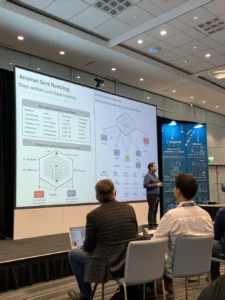Demystifying AI: A Guide to Understanding and Implementing Explainable AI (XAI) Techniques
Navigating the Future: AI, Crypto, and Beyond with Explainable AI (XAI) The world is moving at warp speed. From the volatile crypto markets to the rapid advancements in artificial intelligence, navigating the future requires clarity, foresight, and a deep understanding of underlying mechanisms. One crucial element gaining prominence in this complex landscape is explainable artificial intelligence xai techniques. As AI becomes increasingly integrated into critical decisions – from algorithmic trading to loan applications – understanding how these systems arrive at their conclusions is no longer optional, it's essential. This post delves into the world of XAI, exploring its importance, applications across various sectors, and how it’s paving the way for a more transparent and trustworthy future. We'll explore how trustworthy ai is being developed and applied alongside other emerging trends shaping our world. The Rise of AI and the Need for XAI Artificial intelligence is no longer a futuristic concept; it's a present-day reality transforming industries. Machine learning algorithms power everything from personalized recommendations on streaming platforms to fraud detection in financial institutions. However, many of these algorithms operate as "black boxes" – complex systems where the decision-making process is opaque even to their creators. This lack of transparency poses significant risks. Imagine an AI system denying someone a loan without providing a clear justification. Or an algorithmic trading system triggering a market crash with no discernible explanation. This is where explainable artificial intelligence xai techniques step in. XAI refers to a set of methods and techniques that make AI decision-making more understandable to humans. It aims to provide insights into why an AI model made a particular prediction or took a specific action. The growing demand for trustworthy ai is directly driving the adoption of XAI. Regulatory bodies are increasingly demanding accountability, and users are demanding transparency. XAI Techniques: A Deep Dive Several techniques fall under the umbrella of XAI. Here are some of the most prominent: 1. Feature Importance This technique identifies the input features that have the most significant influence on the AI model’s output. It reveals which variables are driving the predictions. Permutation Feature Importance: By randomly shuffling the values of a feature and observing the impact on the model's performance, you can determine the feature’s importance. SHAP (SHapley Additive exPlanations) values: SHAP values use concepts from game theory to assign each feature a value representing its contribution to the prediction. 2. LIME (Local Interpretable Model-agnostic Explanations) LIME explains the predictions of any classifier by approximating it locally with an interpretable model (e.g., a linear model). It essentially creates a simplified version of the model around a specific data point. 3. Rule-Based Explanations Some AI models, particularly decision trees and rule-based systems, inherently provide explanations in the form of rules. These rules are easy to understand and interpret. 4. Attention Mechanisms Primarily used in deep learning, attention mechanisms highlight the parts of the input data that the model is focusing on when making a prediction. This is particularly useful in natural language processing, where it can show which words are most relevant to a given task. XAI Applications: Transforming Industries The applications of explainable artificial intelligence xai techniques are vast and expanding. Finance: Regulatory compliance requires financial institutions to explain credit decisions, loan approvals, and risk assessments. XAI promotes trustworthy ai in lending, fraud detection, and algorithmic trading. Healthcare: In medical diagnosis, XAI can help doctors understand why an AI system reached a particular diagnosis, supporting informed clinical decision-making. Supply Chain Management: XAI can provide insights into disruptions and inefficiencies in the supply chain, enabling proactive measures. Investing: Understanding the factors driving AI-powered investment strategies can help investors make more informed decisions. Crypto Markets: XAI can help demystify algorithmic trading bots, market sentiment analysis, and risk assessment tools deployed in the cryptocurrency space. Crypto Markets and the Role of XAI The cryptocurrency market is known for its volatility and complexity. Algorithmic trading, fueled by AI, plays a significant role. However, the "black box" nature of these algorithms raises concerns about market manipulation and systemic risk. Explainable artificial intelligence xai techniques can help: Identify potential manipulation: By understanding how algorithms are reacting to market data, we can detect unusual patterns indicative of manipulation. Assess model risk: Evaluating the reasoning behind trading decisions can help quantify the risk associated with each algorithm. Build more robust systems: Incorporating XAI into the development of crypto-related AI systems can lead to more reliable and predictable outcomes. A Comparison of Investment Strategies Strategy Description Risk Level XAI Relevance Algorithmic Trading (High-Frequency) Uses AI bots to execute trades based on pre-defined rules, often reacting to market micro-movements. High Critical – understanding the bot's logic is crucial to avoid unintended consequences. Sentiment Analysis AI analyzes news articles, social media posts, and other text data to gauge market sentiment and predict price movements. Medium to High Important – understanding what factors are driving sentiment predictions builds confidence. Portfolio Optimization AI algorithms build optimal portfolios based on risk tolerance and investment goals. Low to Medium Valuable – understanding the model's asset allocation decisions helps build trust. Decentralized Finance (DeFi) AI AI used for risk management, arbitrage, and strategy optimization within DeFi protocols. Variable High – assessing fairness and transparency in DeFi operations is critical. Looking Ahead: The Future of Explainable AI The field of explainable artificial intelligence xai techniques is rapidly evolving. Future trends include: Developing more user-friendly XAI tools: Making XAI accessible to non-experts will be key to wider adoption. Integrating XAI into the AI development lifecycle: Building transparency into AI systems from the ground up is essential. Standardizing XAI methods: Establishing common metrics and benchmarks will facilitate comparisons and evaluations. Focusing on counterfactual explanations: Explaining what would have happened if a different input had been provided. Conclusion: Embracing Transparency in the Age of AI As AI continues to reshape our world, the need for explainable artificial intelligence xai techniques is more critical than ever. By embracing transparency and understanding how AI systems arrive at their decisions, we can unlock their full potential while mitigating risks and building trustworthy ai solutions. The future of trustworthy ai is inextricably linked to the advancement and adoption of XAI. What are your thoughts on XAI? Share your comments and questions below! Don't forget to share this post with your network using the social sharing buttons below. You can also explore our comprehensive guide on financial markets analysis.
Share this content:














Post Comment